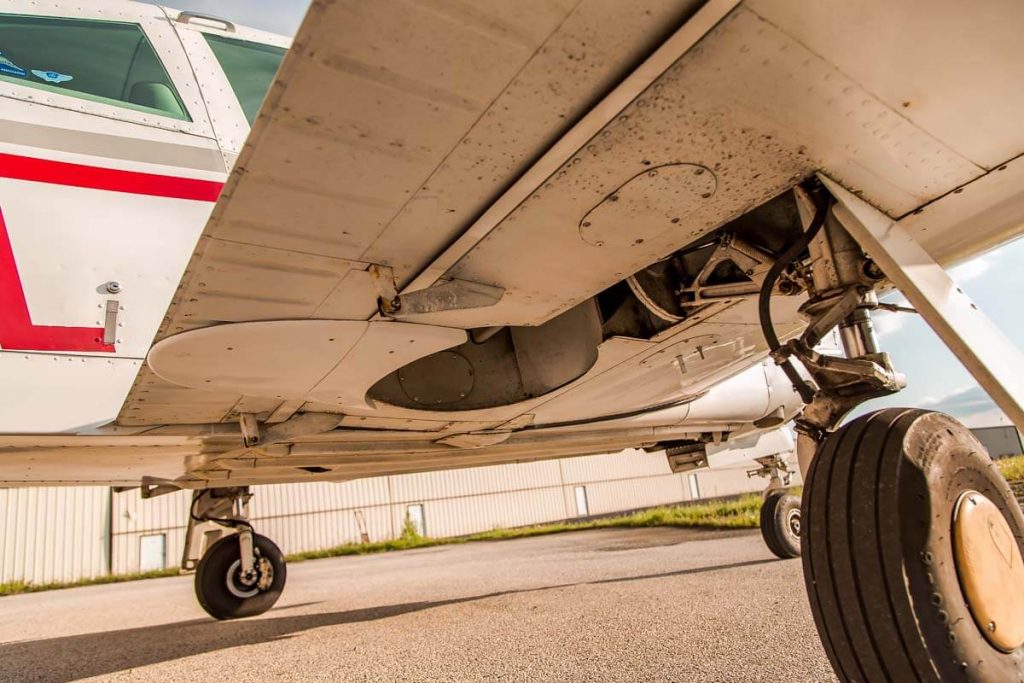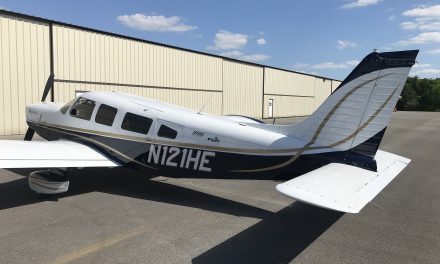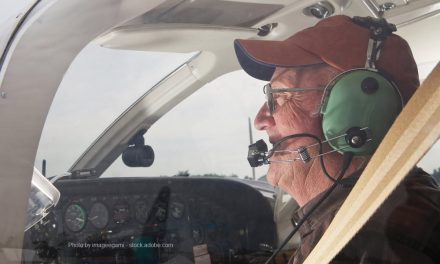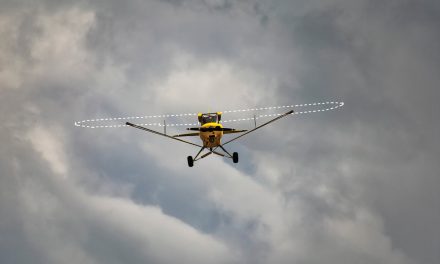
Photo by Jack Fleetwood (www.JackFleetwood.com)
When I started flying, I could not wait to get into an aircraft with retractable gear. The idea of moving up in the aircraft world basically meant getting into bigger, faster, and more complex aircraft. And that meant retractable gear. From a Cessna 150 to a 172 was a big jump, but then to a Cessna R182 retractable gear aircraft — whew! Heady stuff at the time. Talk about ego boosting.
I married into a Cessna dealership family, so I did my initial time in a Cessna R182 and 210. And then in 1980 we got a Cessna 172RG as a trainer for the flight school and that was when I started logging quite a few retractable gear hours. The Cutlass (or Gutless depending on who you talked to) was in my opinion a great aircraft in which to build RG hours.
I know you might say a Mooney M20 or an Arrow is just as good, and you are probably right. But working at a Cessna dealership, we really didn’t keep those, as my father-in-law would say, “brand X” aircraft around very long.
Plus, you could not rent very many complex aircraft in the area. So, the 172RG offered decent speed (130 to 140 knots) at lower fuel burn than a Cessna 182 and, again, it was available. I used to fly the company 172RG around the state for aircraft sales, picking up parts, etc. I remember flying into Sioux City, Iowa, after the United Flight 232 DC-10 crash to pick up a roll of news film. The 172RG got me in and out quickly and efficiently. It did its job very well. I was logging hours in an RG yet spending less money than in the company Cessna 182.
I even used the 172RG to fly to the Seattle area for the Arlington Fly-In one year. Yes, it did the trip comfortably and, no, it was not super-fast. The 172RG is 180 hp, carbureted, and great as a trainer and flatlander aircraft. But over mountains? If I remember correctly, we flew west into the wind over the mountains at 70 knots, full throttle, and 17 inches of manifold pressure. I think we were at about 11,000 feet crossing a few mountains. Remember, I’m used to flying in Iowa and the surrounding states. The trees on the mountain tops seemed very close. I suppose it was not the best long cross-country business plane, but still, the flight was breathtaking and quite an experience. From Iowa to the Seattle area was around 23 hours out and back. Slower and more expensive than the airlines but a heck of a lot more fun!
Complex, high performance, or both?
Let me throw out this disclaimer: I am not a CFI or an FAA employee. So, please confirm the complex requirements with your CFI and FSDO office if you have questions or doubts.
Also, let me say that a complex aircraft is not the same as a high-performance aircraft. You can have the complex but not the high-performance endorsement in your logbook and you can have the high-performance but not the complex. They can be separate and sometimes they go together. You know what, that’s confusing. Here is my tip — just get them both at the same time and be done with it.
Guess that means we should see what the FAA Airplane Flying Handbook says.
“A high-performance airplane is defined as an airplane with an engine capable of developing more than 200 horsepower. A complex airplane is an airplane that has a retractable landing gear, flaps, and a controllable pitch propeller. In lieu of a controllable pitch propeller, the aircraft could also have an engine control system consisting of a digital computer and associated accessories for controlling the engine and the propeller. A seaplane would still be considered complex if it meets the description above except for having floats instead of a retractable landing gear system.”
What is the complex requirement?
A little bit of research shows that the FAA FAR Part 61 Sec. 61.31e states:
“No person may act as pilot in command of a complex airplane, unless the person has:
- Received and logged ground and flight training from an authorized instructor in a complex airplane or a flight simulator/flight training device that is representative of a complex airplane.
- Been found to be proficient in the operation and systems of the airplane.
- Received a one-time logbook endorsement from the instructor.”
A quick side note for those thinking about getting their commercial certificate, the FAA no longer requires a “complex” aircraft to be used during the checkride, which is a good thing because it’s getting hard to find cheap complex aircraft to rent for the commercial training. The catch is the FAA still requires commercial applicants to have recorded 10 hours of complex time in their logbook. So, you still have the issue of renting a complex aircraft somewhere, or just buying one of your own.
Reasons to go complex
Is there really a good reason to go to a complex aircraft? I would bet that if you asked most pilots (especially older ones) why they want a complex aircraft they will probably tell you they want more speed. Complex airplanes go faster. Well, yes that is usually the case. But speed costs money.
Having a complex aircraft increases the maintenance cost because the wheels go up and down and need to be serviced regularly. The propeller also needs service and has a different life span than a fixed-pitch propeller.
There is also potentially more fuel burn because the aircraft is heavier to accommodate the increased weight of the retractable gear. I’m grasping at straws here, so bear with me.
Thinking out loud, some of the newer fixed gear aircraft and modifications that are available for fixed gear aircraft have made them really fast. Meaning, retractable gear and the associated issues that go with them, might not be necessary in all cases.
But in the end, the complex aircraft usually wins out as the simplest way to get more speed for the money. And that’s what we pilots want, folding up the wheels.
Insurance
When it comes to insurance rates, the best rates are on fixed, tricycle gear aircraft. Usually the fewer seats the better, so ultimately a two- or four-place has better rates than a six-place. And the rates of a retractable gear aircraft are higher than a fixed gear.
If you watch the FAA preliminary accident reports, you will notice a large number of gear related incidents/accidents. It seems like almost every day there is a gear up, gear failure, or an “I forgot” accident. And that is only the incidents/accidents that are reported.
I was told years ago, “You either have had a gear up or will have a gear up.” That might not be true for everyone, but it sure is for a lot of pilots. I have had insured pilots who have flown the same aircraft for the last 30 years without an issue and just forgot to put the wheels down.
In 2020 we saw nose gear collapses, main gear failures, and total gear ups. Each situation has its own explanation, and they are not always the pilot’s fault — some are mechanical. But in the end, each loss goes on record as a gear related loss for a complex aircraft. And in the great “actuarial” insurance world, that is going to have an impact on the insurance rates for complex aircraft. Or in other words, the rates will go up, and they have.
If you want a complex aircraft, be prepared. Insurance requirements are stricter, and the rates are higher. That is, if you can get a quote at all. Some aircraft/pilot combinations are just not getting quoted, period.
So, what can you do for the best insurance rates? I’ll say it again, buy a popular, four-place, fixed gear aircraft. Sorry, but for the best insurance rates, that is the best type of plane to own. But if you still want to move to a complex aircraft here are a few things to think about.
- The newer the aircraft the better. Repairs and parts often cost more than the old aircraft, so underwriters are looking at the age of aircraft more closely. In fact, some companies refuse to quote a plane that’s over 30 years old. And the ones that will, well, the rates will reflect that.
- Build hours before you buy. Low total time (under 200 hours) and zero hours in a complex aircraft make it harder to get coverage. Retractable time in any type of aircraft is better than none. If possible, maybe get in a flying club with a retractable gear aircraft for a while.
- The bigger the complex aircraft, the more hours and ratings are needed. Most underwriters want to see an instrument rating before they will consider quoting you in a complex six-seat aircraft like a Lance or a 210. If you want a bigger aircraft, think of it as an incentive to get the instrument rating out of the way. Oh, and build up your total hours.
- Pilot age is critical these days. Underwriters have gotten very particular about older pilots in complex aircraft. Current underwriting will require you to be under 69 years old to transition into a complex aircraft. If you are already qualified (lots of complex hours), you will still be limited in your options. If you are already insured in a complex aircraft and you are over 69, do not let your insurance lapse. If you do, they might not take you back.
- Good maintenance is important. Many of the gear issues are related to poor maintenance and failure of the parts and components that make the gear go up and down. And good maintenance costs money. Do not skimp on gear maintenance.
And one final thing. In the insurance business we ask for updates of how many hours a pilot flies each year so we can try and get the best rates at renewal. Basically, the more hours the better.
But what we see is the faster you go, often the less you fly. I know that sounds crazy, but as the pilot moves up in aircraft speed, it seems to come as a surprise to them when they total their hours for the year. They may be making the same trips, flying the same distances, but each flight was a little faster. As the speeds go up, often the hours they fly go down.
Here’s a thought: If you want to build the most hours per year, fly the slowest aircraft you can.





